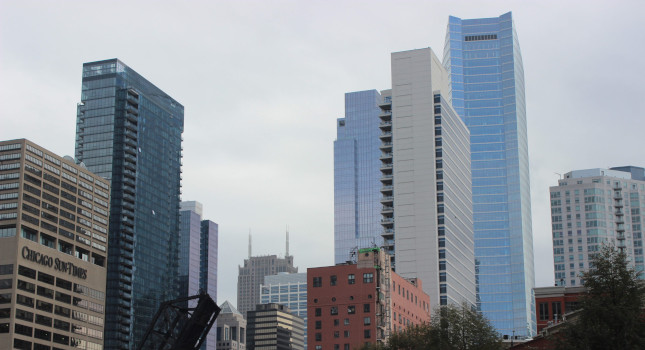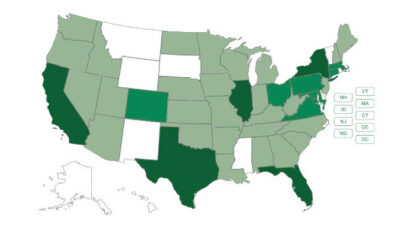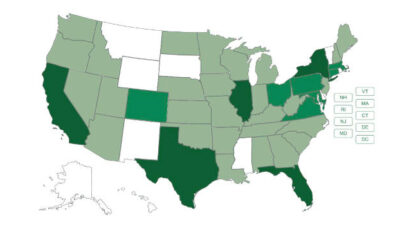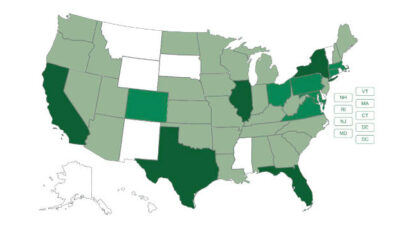Morrissey Goodale is providing A/E leaders with news and perspective on COVID-19 and its impact on the industry. This week, they examine how dispersions could change the A/E industry.

Three waves of disruption could be ahead as dispersion could be taking shape in the A/E industry. Dispersion is the reshaping of distribution removing unnecessary friction and cost. Essentially cutting out the middleman.
There are three dispersions in particular that will impact the A/E Industry: All three were in play to some extent prior to the pandemic and have been accelerated by it. The first is immediately apparent, the second and third are less so – and A/E firms will need to factor them into their post-pandemic business strategies.
Dispersion #1 – HQ: Last spring, the A/E industry – along with most of the rest of the economy – packed up our offices (although we are sure there are still a few fridges in the Bay Area that have yet to cleaned out) and took part in the great 2020 migration to work from home. And over the past year the psyche of the professional class workforce has been changed forever. When lockdowns and distancing regulations are thankfully a thing of the past, “working” will never be the same again. While many employees will be thrilled to return to offices to meet their friends and future life partners (about one in five married couples meet at work), an estimated 20 to 30% will not. And this cohort will expect much more flexibility in how and where they work. This is the dispersion of headquarters (HQ).
First order effect for the A/E industry: Working from home has mobilized a $3 trillion dollar reallocation of capital from the $12 trillion commercial real estate sector to the residential eco system. This demand destruction is real and structural. Commercial real estate – especially office buildings – will shrink, be reimagined and repurposed. A/E firms with business units that read “Workplace” or “Corporate” or “Commercial” will face a smaller, retooled and more competitive market post pandemic. At the same time, A/E firms with end-markets that read “Community Development” or “Residential” or “Multi-family” will see greater demand for new and improved housing stock. Both sectors will see a greater emphasis on Phygital designs – those that blend the physical and digital worlds. Overall, this shift will favor smaller A/E firms.
Second order effect for the A/E industry: The A/E firm of the future will “work” through a blend of employees that collaborate in-person, via 2-D virtual, in Augmented Reality and in 3-D fully immersive VR. Where pre-pandemic a manager may have made 10 trips annually for training and development, in 2022 she will make half that number and replace the balance with virtual or VR meetings. Why? Because she realized during the pandemic, she didn’t have to travel to get the same outcomes and that she could be more cost effective virtually. Office footprints will be reduced – in extreme cases by 90% (there are some REALLY visionary A/E firm leaders out there) — but more likely by 30% to 50%. Lease costs will be lower. Fixed office space will be substituted with on-demand collaboration space (via WeWork or Regus or Airbnb). Startup A/E firms will delay or eschew office investments completely – since it will no longer be a point of pride to “have your name on the door” – as there will be no door. Bricks and mortar as a percentage of revenue for A/E firms will drop from 6 to 8% down to 2% to 4%.
Dispersion #2 – Healthcare: Industries with low net promoter scores (NPS) are ripe for dispersion. Customers tire of dealing with inefficiencies. The Healthcare industry has a woefully low NPS – hence the massive dispersion it is facing. Thirty percent of healthcare spending is on hospitals and hospital services, 20% on physician and clinical services, and 10% on retail prescription drugs. During the pandemic 99% of people who contracted, endured, and overcame the virus or who have received vaccines never set foot in a hospital, doctors office or pharmacy. Telehealth visits jumped from less than 1% of visits to a doctor in the U.S. to 14% in April 2020. Over the past year the delivery of healthcare services has been dispersed from the physical world by digital means. This is a huge time saver for the health services consumer. The trend will continue.
First order effect for the A/E industry: Much like the commercial real estate sector, the medical office sector will shrink and be repurposed as more services are delivered virtually than in person. The ubiquitous Walgreens and CVS pharmacies will shrink (impacting mall design and rents) as prescription drugs get ordered online and delivered by drones. Design firms will face headwinds and cross currents as this sector declines in importance as a physical asset and is reimagined and repurposed.
Dispersion #3 – Higher education: This is the dispersion away from the artificial constraint of campuses to deliver education through technology. Questioning the value of university campuses and administrators is a major third rail topic and there are major institutional and emotional factors resisting change. However, for years the math around higher education has failed to add up. The pandemic has pulled back the curtain on the business model of academia. Universities have high fixed costs and strong unit economics that work well with growing enrollments. When enrollments decline, they are in trouble. After stagnating for a number of years, enrollments plummeted by 20% in 2020 and that has put massive financial pressure on the higher education sector. The luxury brand universities with the largest endowments will be fine. However, most others will have to change and many will not survive. The physical campus will no longer be the exclusive filter through which all content has to run.
First order effect for the A/E industry: Colleges will deliver a greater amount of learning online. They will increase more scale around the delivery of education beyond traditional physical constraints. This will be necessary to expand enrollments (more fee revenue) while decreasing costs (even more profits). So, their business models will migrate away from the physical world to the digital realm. This will result in more headwinds and crosscurrents for A/E firms that make a living designing campus facilities.
It’s not just a river in Egypt. We all know industry disruption is real. We never think it could happen to us. That’s what newspaper owners thought in 2000 just before the internet destroyed their businesses. It’s what taxi medallion owners thought in 2012 before Uber arrived in NYC and upended a 100 year old industry. Disruption will take place through dispersion of HQ, Healthcare and Higher Education. And it will impact the A/E industry, and there will – as always – be winners and losers.
This article originally appeared on Morrissey Goodale’s website. Morrissey Goodale is a CFE Media content partner.



